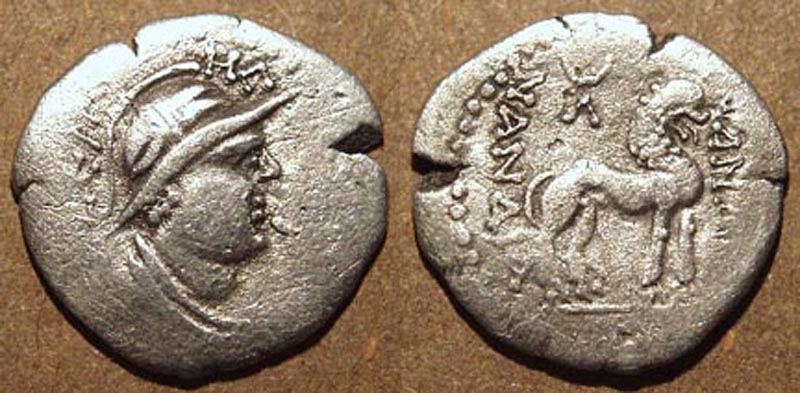
|
|
Once again, the conventional name assigned to this ruler needs to be corrected. Mitchiner, for example,
refers to this ruler as Agesiles. However, Senior has correctly pointed out that the name should read
Arseiles. What Mitchiner and earlier writers have been reading as a Γ is really a Ρ with a
dot replacing the circle at the top of the letter. This form was used during this period.
|

|
Silver hemidrachm
c. 20 BCE
Weight:1.78 gm., Diam:15 mm., Die axis: 10h
Helmeted bust right, greek legend: AΡCEIΛHC /
Lion standing right, tamgha of hill & crescent above
Greek legend right and left: NANAIA
Ref: MAC 2831-32, Senior A4.1. |

|
Silver hemidrachm
c. 20 BCE
Weight:1.91 gm., Diam:15 mm., Die axis: 12h
Helmeted bust right, greek legend: AΡCEIΛHC /
Lion standing right, tamgha of hill & crescent above
Greek legend right and left: NANAIA
Ref: MAC 2831-32, Senior A4.1. |

|
Silver obol
c. 20 BCE
Weight:0.88 gm., Diam:16 mm., Die axis: 1h
Helmeted bust right, greek legend: AΡCEIΛHC /
Lion standing right, tamgha of hill & crescent above
Greek legend right and left: NANAIA
Ref: Senior 4.1a. |
 |
It is not clear whether this coin is actually an obol or a very low weight
hemidrachm. The flan is actually slightly bigger than the earlier hemidrachm. |

|
Silver obol
c. 20 BCE
Weight:0.57 gm., Diam:12 mm., Die axis: 12h
Helmeted bust right, greek legend: AΡCEIΛHC /
Lion standing right, tamgha of hill & crescent above
Greek legend right and left: NANAIA
Ref: Senior 4.1a. |
 |
This coin, with its low weight and small flan, is certainly an obol. |
|
|